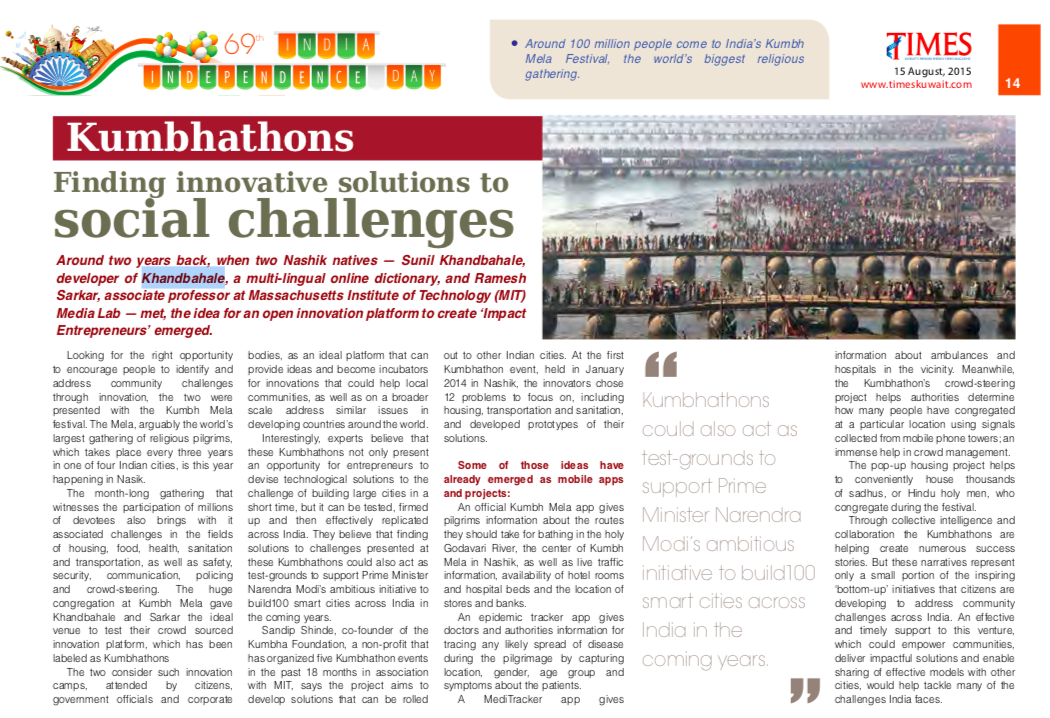Smart City Apps for Urban Challenges

Ask not what your country can do for you, ask what you can do for your country–the quote by J. F. Kennedy may seem like a bit of a cliché but it holds true in the case of India more than ever before. India’s cultural, economic and social diversity is clearly reflected in her cities in the urban issues faced in them. And therefore, no stereotype solution applies to its grand scale; it is the tailor-made approach that suits and works for its conflux of societies. Many citizen initiatives are shaking the city out of its slumber and into the active mode, towards the change. These initiatives are spread across the spectrum of issues specific to a city and certainly come in handy as a source of inspiration to the rest. The municipalities or local city governing bodies can take note and tap into them for cumulative, gross efforts.
For instance, every year in August and September, around 30 million pilgrims are expected to pass through Nashik (Maharashtra) to celebrate the KumbhMela, when the city is normally home to only 1.5 million people. An initiative by Sunil Khandbahale, an entrepreneur from Nashik, and Ramesh Raskar, head of the Camera Culture Group at the MIT Media Lab – Kumbhathon is an innovation platform which can be used to crowdsource solutions for the challenges of the 2015 KumbhMela and create impact entrepreneurship through an open innovation platform. In Bangalore, an initiative by the MOD Institute, a local NGO, enabled residents to come together, online and offline, to create a community vision for the redevelopment of Shanthingar, a neighbourhood of the city. Similarly, the project Next Bengaluru used new technologies to engage local residents in urban planning and tap into their knowledge of the area to promote a vision matching their real needs. The initiative was very successful. In just three months between December 2014 and March 2015 over 1,200 neighbours and residents visited the on-site community space and the team crowdsourced more than 600 ideas for redevelopment and planning both, on-site and through the Next Bangalore website. The MOD Institute now plans to work with local urban planners to try and get these ideas adopted by the city government.
Smaller City scale apps catering to specific solutions can be later bubbled out into state and country initiatives. The Clean India mobile application, for example, encourages Indians to go about and “Swachhify India.” The app, launched at the end of 2014, to coincide with the Modi’s initiative, was developed by Mahek Shah, and allows users to take pictures to report, geolocate and timestamp streets that need cleaning or problems to be fixed by the local authorities. Similar to FixMyStreet, users are able to tag their reports with keywords to categorise problems. Today, Clean India has been downloaded over 12,000 times and has 5,000 active users. Similarly, to the aid anti-corruption movement, the IPaidABribe website and mobile app was created by the grassroots non-profit organisation Janaagraha and launched in 2010 to tackle corruption through crowdsourcing. Today, more than 47,000 reports have been filed on the website in 630+ cities across India. Most reports are about officials and bureaucrats asking for illicit payments for routine services, paperwork and official forms.
The world of Apps is making connections shrink to the size of your pocket. Apps catering to city-based solutions are micro detailing the resources out. It is indeed all about supporting the Smart City initiative on a pan-city level first, one step at a time, and then going on towards a pan country initiative.
source: https://india.smartcitiescouncil.com/article/smart-city-apps-urban-challenges

